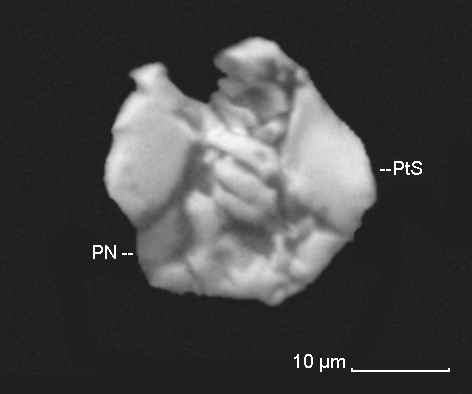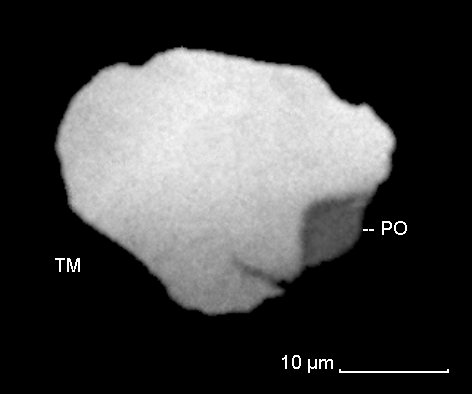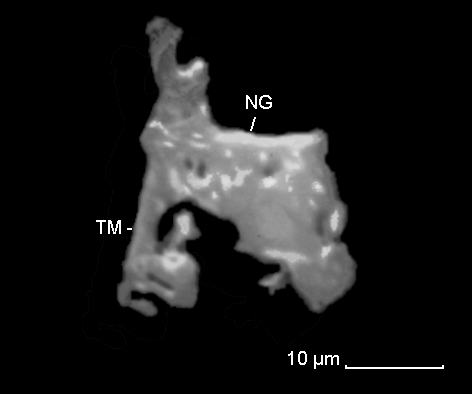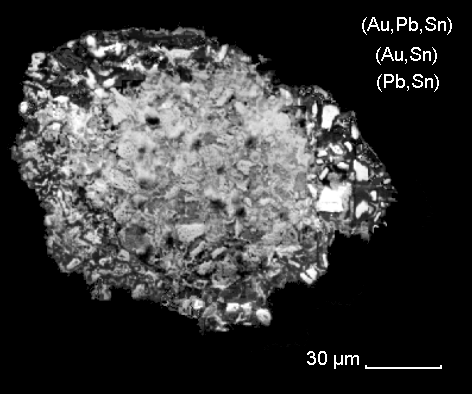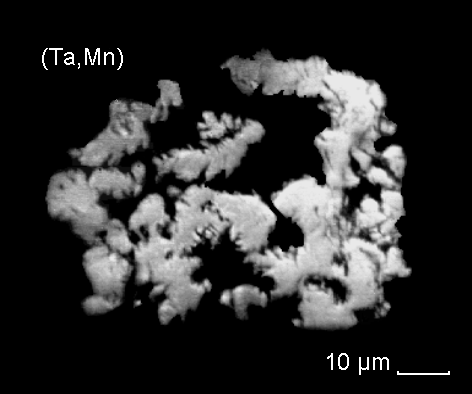PGMs in sulfide oxygenation tailings (Norilsk)
Introduction
One of the elements of copper and nickel extraction technology from ores used for Norilsk deposits is the autoclave-oxygenation process (AOP). This process consists in that the fine milled material (<44µm) residual after previous ore flotation, but containing some part of Cu-Ni sulphide minerals, is supplied in autoclaves, where sulphides are subjected to chemical decomposition at high temperature in oxygen environment. This process is resulted in products to be sent on pyrometallurgy processing, and also in "AOP tailings", which on 85 - 90% consist of iron hydroxides ("red silt"), moreover the size of particles of such composition does not exceed 1-3µm. The other particles to be less than 44µm as a rule presented by magnetite (Fe3O4) and pyrrhotite (FeS) make up to 10-15% of AOP tailings.
The chemical analysis of AOP tailings shows that it include elements of platinum group (PGE, mainly Pd and Pt), moreover their content reaches up to 1-1.5 ppm. The previous investigations does not determine in what phase forms there are these elements and the point of view dominated that Pd and Pt are sorbed on iron hydroxide microparticles in the atomic form. Surely, these notions does not serve as base for setting a working problem induced for Pd and Pt extraction from AOP tailings, therefore for a long time tailings are collected in a dump.
It seems justified, that NATI Research JSC., having technology of "ppm-mineralogy", focused on study of microconcentrations and microparticles, has become interested in a problem on the phase forms Pd and Pt in AOP tailings and has taken part in the decision of this problem. For identification of the phase forms of Pd and Pt two samples of weight about 30g were investigated.
|
Minerals. Back Scattered Electron Microscope Images
Clicking on images provides the higher resolution ones
|
||||
|
1
|
Intergrowth of cooperite (PtS) and a technogenic phase (Cu, Sn). Cooperite is well known in various types of ores of Norilsk. The phase (Cu, Sn) is very rare in ores and probably formed during AOP.
|
|
2
|
Intergrowth of cooperite (PtS) with pentlandite (PN): (Fe, Ni)9S8 Pentlandite is typical mineral of Norilsk ores. Cooperite, along with sperrylite, is one of the most widespread Pt minerals in Norilsk ores, however they are also typical for different Cu-Ni ores. Grain of cooperite is isometric and it is possible to assume that it has relics of primary phases.
|
|
3
|
Intergrowth of taimyrite (Pd, Cu, Pt) 3Sn (TM) with pyrrotite FeS (PO). Pyrrotite is typical mineral Norilsk Cu-Ni ores. Taimyrite is common among minerals of platinum group.
|
|
4
|
Paolovite (PV - Pd2Sn) occurs in Cu-Ni rich ores. The fragments of primary faces are visible.
|
|
5
|
Intergrowth of taimyrite (Pd, Cu, Pt) 3Sn (TM) with niggliite PtSn (NG). The grain is xenomorphic, however obvious sings of dissolution during of AOP are not observed.
|
|
6
|
Sperrylite (SP - PtAs2) is characteristic PGE mineral from rich Cu-Ni ores. The grain boundaries absolutely are not characteristic for sperrylite in ores. Probably sperrylite is dissolved partially during of AOP.
|
|
7
|
Intergrowth of atokite (Pd, Pt)3Sn (AT) with native silver (Ag). Probably, the silver is later mineral and replaces atokite. By character of grain boundaries, it is possible to assume, that the minerals were dissolved partially during of AOP.
|
|
8
|
Agglomerating phases (Au, Pb, Sn), (Au, Sn), (Sn, Pb). The large grain consists of numerous individual phases, which are composed by Au, Sn, Pb in various proportions. In some phases Ni and Cu are identified. Similar agglomerates are not known in ores. Probably the grain has appeared during of AOP. (The viewing in the full image mode is recommended)
|
|
9
|
Intermetallides of gold, tin and cooper. The intermetallides are not known in Cu-Ni ores. It has a technogenic origin during of AOP.
|
|
10
|
Intermetallides of Ni, Sn, Cu, Au and Fe. In Cu-Ni ores are not known. It has a technogenic origin during of AOP.
|
|
11
|
The mineral is not known in ores. A nature, probably, is technogenic: the intermetallide is formed as a result of AOP.
|
|
12
|
Intermetallides of Au-Cu-Sn-Ni-Sb. In ores the intermetallides are not known. A nature, probably, is technogenic: the intermetallides were formed during of AOP.
|
Discussion
The derived data allow making the following conclusions:
- Phase forms of PGE elements in AOP tailings are well known minerals of these elements in Cu-Ni ores of Norilsk deposits. The minerals of noble metals from Cu-Ni ores presented in AOP tailings, are minerals, which have passed without extraction all preceding stages of technological ores treatment in a class of coarse < 44µm without any changes. (See scale rulers on a photo 1 - 7);
- During of autoclave-oxygenation process providing chemical decomposition of sulphides of cooper and nickel, the PGE minerals behave inertly: only some of them bear signs (and no more) of dissolution (see photo 6, 7).
- The gold, in opposite to minerals of PGE, during of AOP is subjected to dissolution and then crystallizes in structure of intermetallides of Sn, Cu, Ni, Sb, Pb. It becomes obvious to take into account foreignness of these intermetallides in ores and size of technogenic phases, which considerably exceeds 44µm that is top limit of particles size on an input in AOP. (See photo 8-12);
- The identification of the phase forms of PGE opens an opportunity of statement of question about extraction of PGEs from AOP tailings at an appropriate choice of extraction technology.


